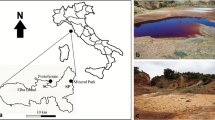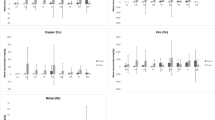Abstract
The use of tree species for phytoremediation of contaminated soil offers the advantage of a large biomass in which to store contaminants. We investigated the cadmium (Cd) and zinc (Zn) accumulation ability of Evodiopanax innovans, a common deciduous tree species belonging to the Araliaceae family and widely found in secondary forests in Japan. Sampling was conducted at an old silver mine. Leaf samples were collected from nine tree species, including E. innovans. The seasonal variation of metal concentrations in the leaves and the detailed distribution of metals in the leaves and twigs of E. innovans were measured. We also analyzed the contents of organic acids in the leaves. The highest concentration of Cd in the leaves of E. innovans was 118 μg/g, which exceeds the threshold level for being considered a Cd hyperaccumulator (100 μg/g). For Zn, the highest value was 1040 μg/g in leaves, which is less than required to qualify as a Zn hyperaccumulator. Both Cd and Zn were found to accumulate in the petioles and veins of leaves and the bark of twigs. Since the oxalic acid content of leaves showed a weak correlation with Cd concentration, oxalic acid may play an important role in the accumulation of Cd. Taking both the Cd concentration level and the biomass of this woody plant into consideration, it may be possible to use E. innovans for the phytoremediation of Cd-contaminated soils.







Similar content being viewed by others
References
Baker, A. J. M., Reeves, R. D., & Hajar, A. S. M. (1994). Heavy metal accumulation and tolerance in British populations of the metallophyte Thlaspi caerulescens J & C Presl (Brassicaceae). The New Phytologist, 127, 61–68. doi:10.1111/j.1469-8137.1994.tb04259.x.
De la Rosa, G., Martínez-Martínez, A., Pelayo, H., Peralta-Videa, J. R., Sanchez-Salcido, B., & Gardea-Torresdey, J. L. (2005). Production of low-molecular weight thiols as a response to cadmium uptake by tumbleweed (Salsola kali). Plant Physiology and Biochemistry, 43, 491–498. doi:10.1016/j.plaphy.2005.03.013.
Dickinson, N. M. (2000). Strategies for sustainable woodland on contaminated soils. Chemosphere, 41, 259–263. doi:10.1016/S0045-6535(99)00419-1.
Greger, M. (1999). Metal availability, uptake, transport and accumulation in plants. In M. N. V. Prasad (Ed.), Heavy metal stress in plants (pp. 1–27). Berlin: Springer.
Hall, J. L. (2002). Cellular mechanisms for heavy metal detoxification and tolerance. Journal of Experimental Botany, 53, 1–11. doi:10.1093/jexbot/53.366.1.
Krämer, U., Cotter-Howells, J. D., Charnock, J. M., Baker, A. J. M., & Smith, J. A. C. (1996). Free histidine as a metal chelator in plants that accumulate nickel. Nature, 378, 635–638. doi:10.1038/379635a0.
Kubota, H., & Takenaka, C. (2003). Arabis gemmifera is a hyperaccumulator of Cd and Zn. International Journal of Phytoremediation, 5(3), 197–201. doi:10.1080/713779219.
Memon, A. R., & Yatazawa, M. (1984). Nature of manganese complexes in manganese accumulator plant—Acanthopanax sciadophylloides. Journal of Plant Nutrition, 7(6), 961–974.
Mertens, J., Vervaeke, P., Meers, E., & Tack, F. M. G. (2006). Willow (Salix sp.) stands for phytoremediation on dredged sediment. Environmental Science and Technology, 40, 1962–1968. doi:10.1021/es051225i.
Miyake, H., Okamoto, H., Hirose, T., Izuta, T., & Totsuka, T. (1993). Growth characteristics of the heavy metal resistant fern Athyrium yokoscense in a polluted distinct by copper smelter. Man and the Environment, 19, 2–11. in Japanese.
Pulford, I. D., & Watson, C. (2003). Phytoremediation of heavy metal-contaminated land by trees—a review. Environment International, 29, 529–540. doi:10.1016/S0160-4120(02)00152-6.
Robinson, B. H., Leblanc, M., Petit, D., Brooks, R. R., Kirkman, J. H., & Gregg, P. E. H. (1998). The potential of Thlaspi caerulescens for phytoremediation of contaminated soils. Plant and Soil, 203, 47–56. doi:10.1023/A:1004328816645.
Rosselli, W., Keller, C., & Boschi, K. (2003). Phytoextraction capacity of trees growing on a metal contaminated soil. Plant and Soil, 256, 265–272. doi:10.1023/A:1026100707797.
Takada, J., Takamatsu, T., Satake, K., & Sase, H. (1994). Data on elemental concentration in land plants by neutron activation analysis (No.1). Report F-58-’93. National Institute for Environmental Studies, Japan.
Ueno, D., Ma, J. F., Iwashita, T., Zhao, F. J., & McGrath, S. P. (2005). Identification of the form of Cd in the leaves of a superior Cd-accumulating ecotype of Thlaspi caerulescens using 113Cd-NMR. Planta, 221, 928–936. doi:10.1007/s00425-005-1491-y.
Zhou, W., & Qiu, B. (2005). Effects of cadmium hyperaccumulation on physiological characteristics of Sedum alfredii Hance (Crassulaceae). Plant Science, 169, 737–745. doi:10.1016/j.plantsci.2005.05.030.
Author information
Authors and Affiliations
Corresponding author
Rights and permissions
About this article
Cite this article
Takenaka, C., Kobayashi, M. & Kanaya, S. Accumulation of cadmium and zinc in Evodiopanax innovans . Environ Geochem Health 31, 609–615 (2009). https://doi.org/10.1007/s10653-008-9205-6
Received:
Accepted:
Published:
Issue Date:
DOI: https://doi.org/10.1007/s10653-008-9205-6




